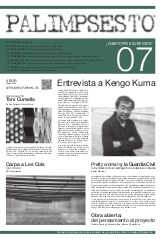Aga Khan Historic Cities Programme
DOI:
https://doi.org/10.5821/pl.v0i7.1281Abstract
At the end of the 1970s, the need for leaving modern architecturebehind and the blind faith in progress gave wayto different forms of articulating our relation with history andreligion, especially in Muslim countries. Under these circumstancespostmodernism emerged, allowing the use ofhistoric architecture, once more, as a tool for defining theidentities of the different communities of the planet.
Historic cities in the Islamic world host more than one third ofthe World Heritage, as defined by UNESCO. Unfortunately,is some cases these cities correspond to the world’s poorestcommunities, where the built heritage keeps deteriorating.Under such conditions, how can these historic cities, all ofthem of great inspirational value for future generations, berecovered without transforming them into uninhabited museums?How can the process of nullifying the authenticityof these urban settlements be avoided? The projects presentedat this exhibition illustrate different approaches foranswering all these questions, all of them situated undera global perspective that goes beyond the simple materialconservation of the built heritage. For all these projects, cultureworks as the main structural axis of socio-economicdevelopment. Sharing strategies and tools, both private andpublic, becomes the main goal in order to preserve the legacyfrom the past, the cultural diversity and the livability ofhistoric cities.
Downloads
Issue
Section
License
PROTECTION AND INTELLECTUAL PROPERTY CRITERIA
Authors whose work is published in en Palimpsesto agree to the following terms:
1. The author retains the copyrights and guarantees the magazine the right to apply a Creative Commons Attribution-NonCommercial-NoDerivatives (CC BY-NC-ND), which permits others to share the work with acknowledgement of authorship.
2. The author may establish additional agreements of his or her own accord for non-exclusive distribution of the article published in the magazine (for example, in an institutional repository, or published in a book).
3. Electronic distribution of the work by the author(s) is permitted and encouraged (for example, in institutional repositories or on the author’s own website), prior to, and during the submission process, as this can generate productive exchanges, as well as earlier and greater citation of the published works (see The Effect of Open Access) (in English).
4. The author or provider of the material submitted for publication authorizes Palimpsesto to publish, with no obligation whatsoever (financial or otherwise) to the content of said material, be it in paper or digital format, or in any other medium.
5. The author or provider guarantees that he or she is the owner of the Intellectual Property rights to the contents provided, which encompasses the text and images/photographs/photographic works incorporated in the article.
6. The author or provider, exempts Palimpsesto magazine of all and any responsibility relating to violation of copyrights, thereby committing himself or herself to undertaking all efforts to assist Palimpsesto magazine in defence of any accusation, extra-judiciary, and/or judicial measures. Likewise, the author or provider will assume payment to Palimpsesto of any sum or compensation that must be paid to third parties for failure to comply with these obligations, be it the result of judicial, arbitrary or administrative decisions.
7. The submission of the texts by authors implies automatically a declaration of non plagiarism of its contents







